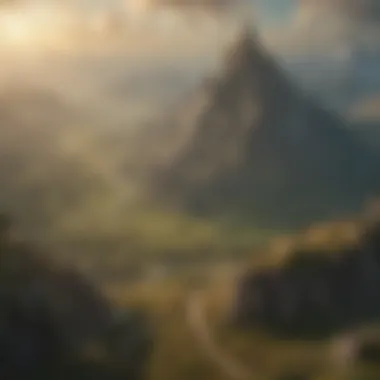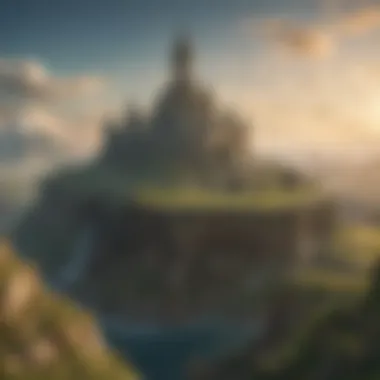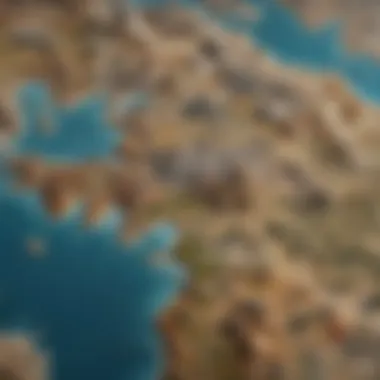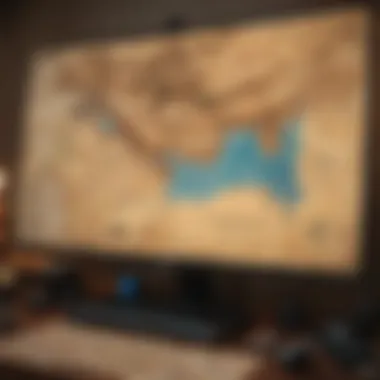Understanding the Map Poster of Breath of the Wild


Intro
In the vast landscapes of Hyrule, navigating the world of The Legend of Zelda: Breath of the Wild can feel like both a grand adventure and an overwhelming challenge. The intricacies of its expansive map come alive through the map poster that accompanies the game. This poster is not just a simple reference tool; it carries layers of meaning rich for both seasoned players and those just dipping their toes into the waters of this iconic franchise.
So why does this map matter? For many gamers, the poster serves as a visual embodiment of what makes Breath of the Wild not just a game, but a living world. Players can trace the paths they’ve walked, the enemies they’ve bested, and the mysteries they’ve unraveled. To fully understand its importance, let’s dive deeper into the elements that intertwine the aesthetics and practicality of the map poster.
Understanding the Map Poster
Seen prominently in many players’ rooms or adorned on gaming forums, the map poster of Breath of the Wild is more than a decorative piece. It’s a roadmap to adventure, bursting with vibrant details and intricate cartography that showcase Hyrule’s rich tapestry of environments, from towering mountains to verdant forests.
Design Elements
At first glance, the map pulls you in. The colors are vivid, echoed throughout the game itself, reflecting the diverse terrains. Each zone has its own color palette—and the poster encapsulates this beautifully. The design is not just eye candy but functional too. Landmarks, shrines, and stables are clearly marked, making it easy for players to orient themselves in an unfamiliar world.
- Vibrant Colors: Captures the essence of each region.
- Landmarks: Clearly labeled, aiding memory recall.
- Orientation: Aids new players to map their journey effectively.
Practical Applications for Gameplay
The usefulness of the map extends into actual gameplay. Players can use the map poster to plan their journeys or remind themselves of certain locations they want to explore or revisit. For example, if you’re hunting for a specific shrine or wanting to battle a particular boss again, a glance at the map can streamline your travels.
Moreover, it acts as a communal point for fans. Players might get together to reminisce about spots they struggled to reach or share tips on finding hidden treasures. It becomes a tool of engagement, connecting fans in ways that the game alone cannot.
Aesthetic Appeal
But let’s not overlook its aesthetic importance. Hanging it on a wall is like displaying a piece of art; every detail promotes both nostalgia and excitement for what lies within the game. The map visually represents the adventure and serves as a daily reminder of the epic journey players embark upon. It helps one keep the spirit of exploration alive, even when they're not engaged in the game itself.
"A map is not just a piece of paper; it’s a window into another world, beckoning you to explore its depths."
Preamble to the BotW Map Poster
When discussing the intricacies of The Legend of Zelda: Breath of the Wild, one cannot overlook the contribution of the map poster. It’s not merely a piece of artwork or a guide — it serves as a vital tool, a compass, if you will, pointing players towards exploration and adventure. This section will shed light on the multifaceted importance of the BotW map poster, detailing its purpose and the broader context of Breath of the Wild itself.
Purpose of the Map Poster
The map poster plays multiple roles in the experience of Breath of the Wild. First and foremost, it offers a well-structured representation of Hyrule’s vast geography, making exploration not just feasible but also more enjoyable.
- Visual Aid: The intricate design allows players to visualize their surroundings, helping them navigate with more confidence.
- Exploration Tool: For those casual adventurers or meticulous explorers, having a physical reference enhances the gameplay. Players can easily plan routes, spot landmarks and mark spots of interest as they journey through the game.
- Immersive Experience: Aesthetically pleasing, the map poster enriches the game's lore. It breathes life into Hyrule, showcasing various regions, and igniting curiosity about hidden treasures and secrets.
In brief, the map poster is not just functional; it's a blend of utility and artistry that allows gamers to immerse themselves deeper into the world, igniting a sense of wonder.
Overview of Breath of the Wild
Breath of the Wild is not your average installment in the Zelda franchise; it’s a groundbreaking adventure that reshapes the conventions of open world gaming. Released in 2017, it invites both veterans and newcomers into a beautifully crafted world teeming with possibilities.


The game's sprawling landscapes, from the towering mountains of the Hebra region to the lush forests of Faron, create an environment that's ripe for exploration. Players are encouraged to wander off the beaten path, seeking out shrines, fighting mighty foes, or simply enjoying the view from a cliff.
Several key components highlight the essence of the game:
- Open World Environment: Unlike previous titles, this one allows free movement and exploration. Players are not restricted to linear paths; they can embark on personal quests and take on challenges in any order they choose.
- Dynamic Weather System: The weather not only changes the visual aesthetics but also influences gameplay, adding an additional layer of strategy when planning adventures. Rain might make climbing a slippery endeavor, but it might also lead to hidden discoveries.
- Player Agency: Every action in Breath of the Wild feels significant. The choices made can impact the game's outcome, leading to a personalized experience for each player.
In sum, understanding Breath of the Wild's dynamic nature is crucial for appreciating the significance of the map poster. The two work in tandem to enhance the gaming experience, providing players with both guidance and inspiration as they explore Hyrule's rich tapestry.
Design Characteristics of the Poster
The design characteristics of the Breath of the Wild map poster play a significant role in shaping the overall experience for both gamers and collectors alike. This poster is not just a simple representation of the game’s extensive world. It's an artistic embodiment of Hyrule that visualizes the lore and invites players to delve deeper into its diverse landscapes. These design elements contribute not only to its aesthetic appeal but also serve practical functions that enhance gameplay.
Artistic Influences
The artistry of the Breath of the Wild map poster showcases a fusion of traditional and modern artistic influences. One can draw parallels to classical cartography, which often emphasized beauty alongside practicality. This poster counters the digital simplicity found in many contemporary map designs, introducing textures and layers reminiscent of hand-drawn illustrations.
This approach injects life into locations like Hyrule Field and the gripping heights of Death Mountain, which leap off the page. Influences from Japanese art, especially Ukiyo-e, are noticeable not only in the way landscapes are represented but also in how colors harmonize. Colors that drip with emotion and depth to create a feeling of nostalgia resonate deeply with players who venture through these iconic places. Ultimately, the artistic influences present a map that serves both the eye and the mind, echoing the intricacies found in the game itself.
Color Palette and Aesthetics
When examining the color palette and aesthetics of the Breath of the Wild map poster, one can't help but notice the vibrant yet earthy tones that dominate the design. The use of soft greens and browns invoke the rolling hills and vast forests, establishing a sense of tranquility. Contrast this with the sharp blues of the water bodies and fiery reds of volcanic regions, and you have a stunning visual representation of Hyrule’s varied environment.
The aesthetics extend beyond mere colors. The way the hues transition between regions—smooth, gradual shifts that one can almost feel—draws attention to Hyrule’s diverse biomes and climate shifts.
A well-crafted map does more than just guide; it immerses.
Furthermore, the layout of landmarks and regions encourages exploration and adventure. Subtle details, like the seasonal changes reflected through the use of color, enhance reproduction of the game’s dynamic world. Players may find themselves drawn into daydreams or memories of their own quests, feeling that they could simply walk right into the world depicted within the poster.
In summary, the design characteristics of the BotW map poster create a multi-dimensional engagement with the fantastical world of Hyrule. Through thoughtful artistry and deliberate color choices, the poster not only enhances one’s understanding of the game’s geography but also significantly contributes to its emotional resonance, making it an essential piece for both casual fans and ardent collectors.
Map Features and Landmarks
When diving into the intricacies of the Breath of the Wild map poster, one crucial aspect that stands out is its map features and landmarks. These elements not only enhance the visual experience of the poster but also serve a practical purpose for players. The topography and scattered locales depicted provide an invaluable road map through Hyrule, breathing life into the vast landscape that players explore.
Key Locations Within Hyrule
The legend of Zelda is celebrated for its rich storytelling and expansive worlds. Within this context, key locations sprinkled throughout Hyrule serve as focal points for player exploration. On the poster, icons highlight places like Hyrule Castle, the Lost Woods, and more obscure areas such as the Akkala Ancient Tech Lab or the Faron Grasslands. Each of these spots comes with its own lore and associated quests, creating a tapestry of experiences waiting to be unraveled.
Key Locations to Consider:
- Zora’s Domain: A beautifully designed underwater kingdom, Zora’s Domain acts as an essential point for the water-based mechanics of the game.
- Gerudo Valley: This arid landscape challenges players as they navigate its sandy dunes and harsh climates, adding diversity to the game’s environments.
- Rito Village: Perched high in the mountains, Rito Village represents the connection between sky-bound quests and icy terrains, adding nuance to the overall map.
Understanding these locations allows players to set their course and strategize effectively on their journeys. Rather than wandering aimlessly, a glance at the poster can provide a quick reference to areas of interest, enhancing gameplay enjoyment and efficiency.
Understanding the Terrain


To immerse oneself fully in Breath of the Wild, grasping the terrain is vital. The map poster visually encapsulates a variety of environments—rolling hills, mountainous terrains, and dense forests among others. These geographical features not only look inviting, but they also influence gameplay mechanics.
Terrain Considerations Include:
- Elevation: High altitudes, such as those found in the Hebra Mountains, require specific gear, like warmth-boosting clothing, to survive.
- Water Bodies: Lakes and rivers can either be a blessing or a curse. Players need to consider swimming stamina, depth, and currents while traversing.
- Vegetation Types: Forests are usually teeming with resources, but they might also hide foes or puzzles, emphasizing the need for cautious navigation.
Ultimately, the mountains, fields, and rivers that define Hyrule's geography serve as more than just pretty backdrops; they are integral to the gameplay experience. By decoding the topographical cues of the map poster, players manifest a clearer understanding of potential paths, risks, and rewards that await them.
"The landscape of Hyrule isn't just about aesthetics; it's a living part of the journey, influencing every adventure one might undertake."
In summary, map features and landmarks exhibited on the Breath of the Wild poster are not merely decorative. They root players in the game’s universe and actively guide their navigation through Hyrule, making each adventure not just memorable, but also strategic.
Utility of the Map Poster in Gameplay
When players dive into the vast world of Hyrule in The Legend of Zelda: Breath of the Wild, they quickly realize that navigation is key. The map poster serves not just as a pretty piece of art, but as an essential tool for exploration and gameplay. Its utility transcends mere decoration, offering practical insights that enhance the overall experience.
Navigation and Exploration Tips
Navigating Hyrule can feel like looking for a needle in a haystack, especially with its sprawling landscapes. The map poster provides a visual guide to the incredible variety of environments in the game. Here are a few ways to leverage the map for better navigation:
- Landmark Recognition: Familiarize yourself with major landmarks. The poster highlights the locations of iconic sites like Hyrule Castle, Death Mountain, and the Great Plateau. This can be your reference point when exploring the game.
- Topographical Awareness: Pay attention to the terrain features depicted on the map. Whether it’s lush forests or rocky cliffs, understanding the geography helps in planning your route and prepares you for the challenges ahead.
- Travel Points: Make note of the fast travel points marked on the map. These are crucial for getting from one area to another quickly, especially when you’re on a quest or hunting for shrines.
- Dungeon Locations: The poster subtly marks the entrances to dungeons. Knowing where these are can save time and prevent unnecessary wandering.
"A well-prepared adventurer knows their terrain. A map is worth its weight in rupees."
Armed with this knowledge, players can methodically explore Hyrule without feeling overwhelmed by its size. It streamlines the adventure, allowing one to enjoy the game’s intricate design and storytelling.
Quests and Challenges Reference
In addition to navigation, the map poster also serves as a vital resource for quests and challenges throughout Breath of the Wild. Here’s how it comes into play:
- Quest Tracking: Many quests are tied to specific locations in the game. When a quest directs you to a region, having a poster means you can quickly locate that area. This saves precious time as you won’t have to circle around different regions aimlessly.
- Challenge Awareness: Players engaging in certain challenges, like the ‘Korok Seed Hunt,' can refer to the map to strategize their route. Seeing where potential collectible seeds are hidden on the poster can transform the daunting task into a structured plan.
- Event Planning: Seasonal events or special missions often occur in designated areas. Marking these on your map provides a visual cue for when and where to focus efforts during particular events.
- Exploration Incentives: Some quests reward players for exploring uncharted territories. The map can encourage players to venture into lesser-known regions, sparking curiosity and enhancing the overall experience.
Cultural Impact of the Map Poster
The map poster of The Legend of Zelda: Breath of the Wild serves more than just a visual guide to Hyrule; it holds significant cultural weight for both the fanbase and the broader gaming community. This section explores how this artifact reflects community interaction, serves as a piece of art, and holds a collectible value that resonates with many.
Fan Community Engagement
The engagement surrounding the Breath of the Wild map poster extends far beyond mere appreciation of its aesthetics or utility. Fans often gather in online platforms like Reddit or dedicated Facebook groups to discuss various intricacies of the game. The poster acts as a focal point during these discussions; it is a tangible item that highlights the vastness of Hyrule, encouraging players to share their adventures and strategies.
Many players post reviews or guides that cite specific locations on the map, further enhancing community knowledge. It encourages collaborative exploration and play, where some fans may even draw on the poster to pin point locations for challenges or quests. This collective effort not only builds friendships but creates a deeper sense of belonging within the gaming community. It fosters a pride in mutual interests, often leading to fan art that showcases how these gamer journeys intersect with the rich lore of the Zelda universe.
Merchandising and Collectible Value


From a merchandising perspective, the map poster represents more than an in-game reference; it's a collectible that many enthusiasts covet. After its release, various versions became available—framed editions, limited runs, or artist-signed prints. Each variant adds to its allure, appealing to individuals who see value not just in the practical use of the map, but as an aesthetic piece of gaming history.
Collectors often discuss the value of such items in forums, likening them to fine art. In this sense, the map transcends mere merchandising; it is a symbol of Breath of the Wild’s impact on the gaming culture. The map evokes nostalgia and recognition of the journey players have undertaken within Hyrule, thus boosting its desirability. Owners frequently share their poster displays and how they integrate the art into their gaming setups.
"The map is like a window to Hyrule’s heart. It represents not just a game, but a world full of stories shared among players."
Through a blend of art, community engagement, and collectible appeal, the Breath of the Wild map poster marks its significance in the cultural landscape of gaming. As players continue to explore Hyrule, this map stands as an emblem of shared experiences and passionate fandom that speaks to generations of gamers.
Comparison With Other Zelda Game Maps
Examining how the map of Breath of the Wild compares with those from other Zelda titles provides insights into the evolution of design philosophy within the franchise. These maps are not just functional; they reflect a progression in how game worlds are structured and explored. Understanding their differences puts into perspective the innovations introduced in Breath of the Wild, solidifying its place in the series' lineage.
Evolution of Map Design in the Series
The evolution of map design in The Legend of Zelda series is akin to an artist sharpening their chisels and brushes through practice. From the original top-down view of the first game to the dramatic open-world concept of Breath of the Wild, each design shift tells a story of gameplay priorities and player engagement.
- The Original Zelda: The very first game introduced a simple grid-like map, encouraging exploration through a sense of mystery. Players could roam around freely but were given minimal guidance. The map was a puzzle in itself, forcing players to navigate with intuition and memory.
- 2D Adventures (Link to the Past and Others): These maps expanded on the original's concept by adding more diverse environments and layered structures. The world felt interconnected, with secret areas and hidden treasures that rewarded curious players.
- 3D Transitions: With titles like Ocarina of Time and Majora's Mask, maps transitioned to a three-dimensional space. This shift brought about complexity in navigation, with depth and verticality. These worlds were designed to be explored in various ways, introducing a z-axis to the exploration formula.
- Increasing Size and Complexity: As technology progressed, the expansiveness of maps grew. Wind Waker utilized a vast oceanic expanse, while Twilight Princess provided a richly detailed world. Yet, even with significant environments, players often encountered segmented areas, which sometimes limited exploration and immersion.
Each step in this evolution emphasizes an understanding of player agency, leading up to the revolutionary approach seen in Breath of the Wild.
BotW vs. Previous Installments
Breath of the Wild stands apart not just as a continuation of the series but as a revolution in gaming experiences. This game’s map is a work of art that integrates freedom with intricate design, allowing players to traverse Hyrule in nearly any direction they choose. Here are some distinct comparisons:
- Open-World Mechanics: Unlike previous games, where players moved through a more linear structure or connected regions, BotW encourages exploration without barriers, inviting users to climb mountains or glide through valleys on a whim.
- Dynamic Environments: The map is full of interactivity—weather changes affect gameplay, and the environment responds to Link’s actions. This makes each journey unique, as successes and failures shape the experience in real-time.
- Diverse Ecosystems: Every region has a unique vibe, from lush forests to arid deserts, engaging players with varied wildlife, materials, and resources to discover. Past games, while rich, often relied on familiar landscapes that felt repetitive by the end of the journey.
- Clarity of Purpose: The map not only serves as a tool for navigation but also as a narrative device. Key locations are often tied deeply into the game’s lore, fostering an emotional connection to the geography of Hyrule.
Breath of the Wild has raised the bar, and the thoughtful, intricate nature of its map serves to breathe life into every player’s individual adventure.
A map is not just a representation of space; it's a gateway to exploration and discovery.
End: The Lasting Legacy of the BotW Map Poster
The map poster for The Legend of Zelda: Breath of the Wild carries more than just a visual representation of Hyrule; it serves as a bridge connecting players to the game’s multifaceted world. Its significance is not limited to mere aesthetics but extends into the realms of gameplay and community. An analysis of this poster reveals how it encapsulates the essence of exploration and adventure that defines the Zelda franchise.
Future of Map Posters in Gaming
As gaming evolves, so does the way that developers and fans engage with maps. The success and reception of the BotW map poster set a precedent for future releases. Moving forward, one can expect:
- Enhanced Interactivity: Future maps may incorporate augmented reality features, allowing players to explore the map in an immersive way, possibly seeing key landmarks or quests overlaid in real-time.
- Dynamic Content: With the rise of online gaming, maps could become updated dynamically with user-generated content or real-time events, fostering a deeper connection between game worlds and their communities.
- Merchandising Evolution: As gaming becomes more mainstream, the demand for high-quality map posters as collectibles will likely grow. Companies may produce limited editions, catering to dedicated fans eager to enhance their gaming spaces.
While technology advances and player expectations shift, the fundamental role of a map remains intact: it guides players through their journeys, creating lasting memories.
Final Thoughts on Player Experience
In closing, the BotW map poster is a testament to how a simple, yet intricately designed, object can greatly enhance player immersion in a game. For many gamers, this poster acts as more than a navigation tool; it symbolizes the adventure and discovery that lie within the game’s expansive landscapes. Through this single piece of art, players can:
- Foster Emotional Connections: The poster often evokes nostalgia and excitement, reflecting personal adventures taken in-game.
- Encourage Exploration: It invites players to revisit locations they might have overlooked about their initial playthrough, adding layers to their experience.
- Promote Community Sharing: As fans exhibit their maps online or share stories tied to specific locations within the game, it unites a vibrant community, fostering discussions and shared discoveries.
"The beauty of a map is not in its accuracy, but in the adventures it inspires and the memories it creates."
Thus, the legacy of the BotW map poster will undoubtedly continue to resonate with gamers, standing as a powerful symbol of exploration, discovery, and the timeless joy that gaming brings. Its impact will shape future map design and community engagement, making it a significant touchstone for both developers and players alike.



